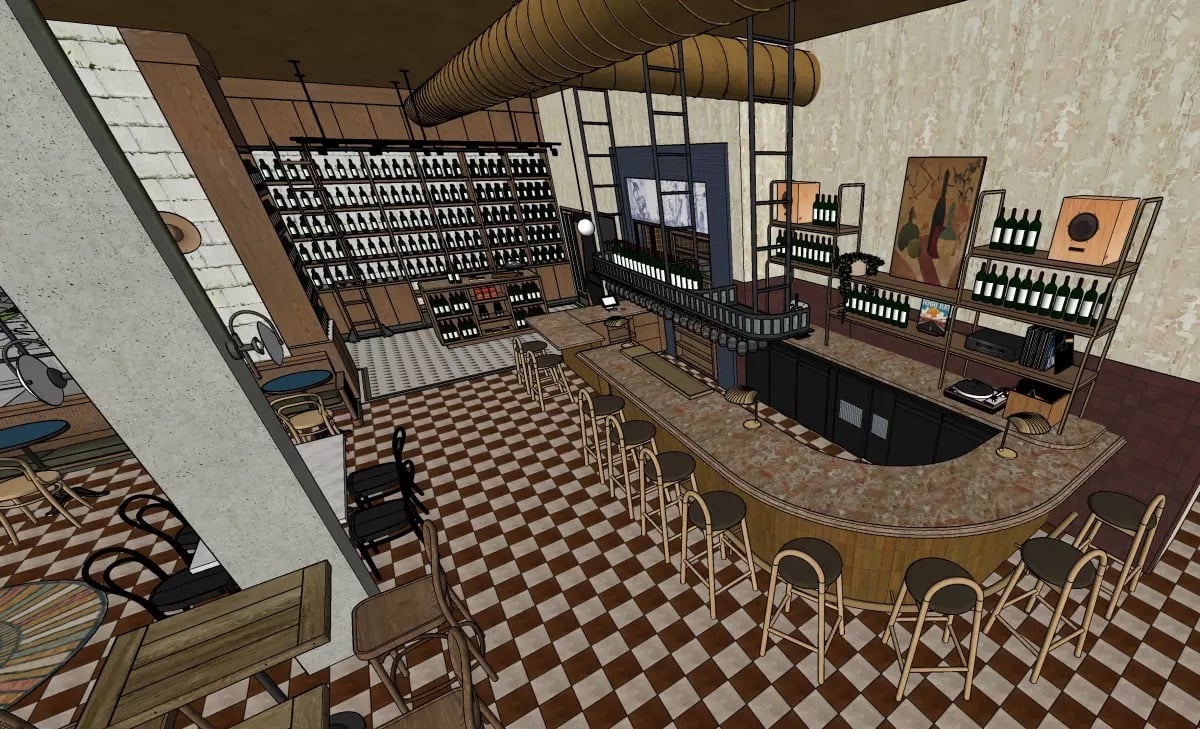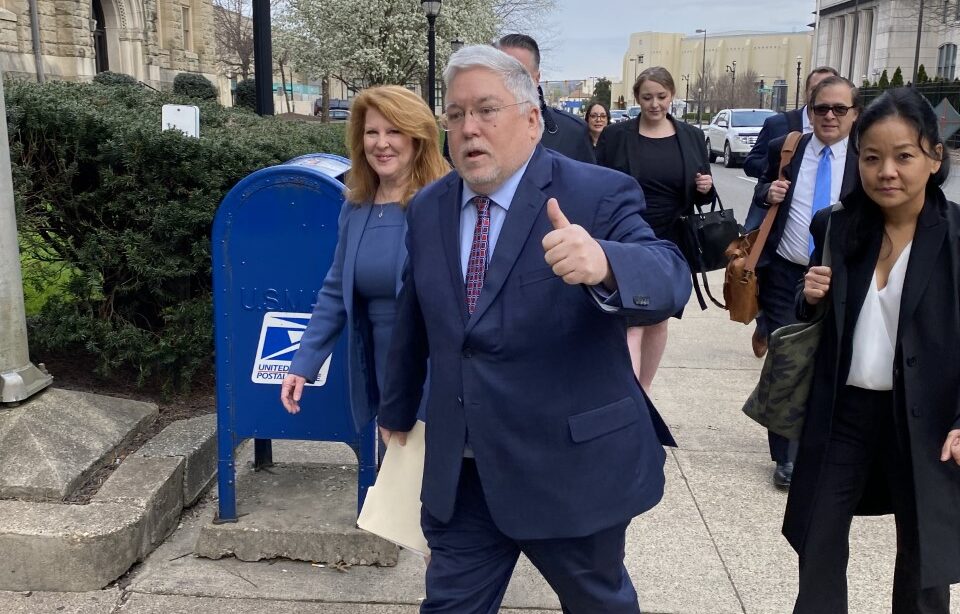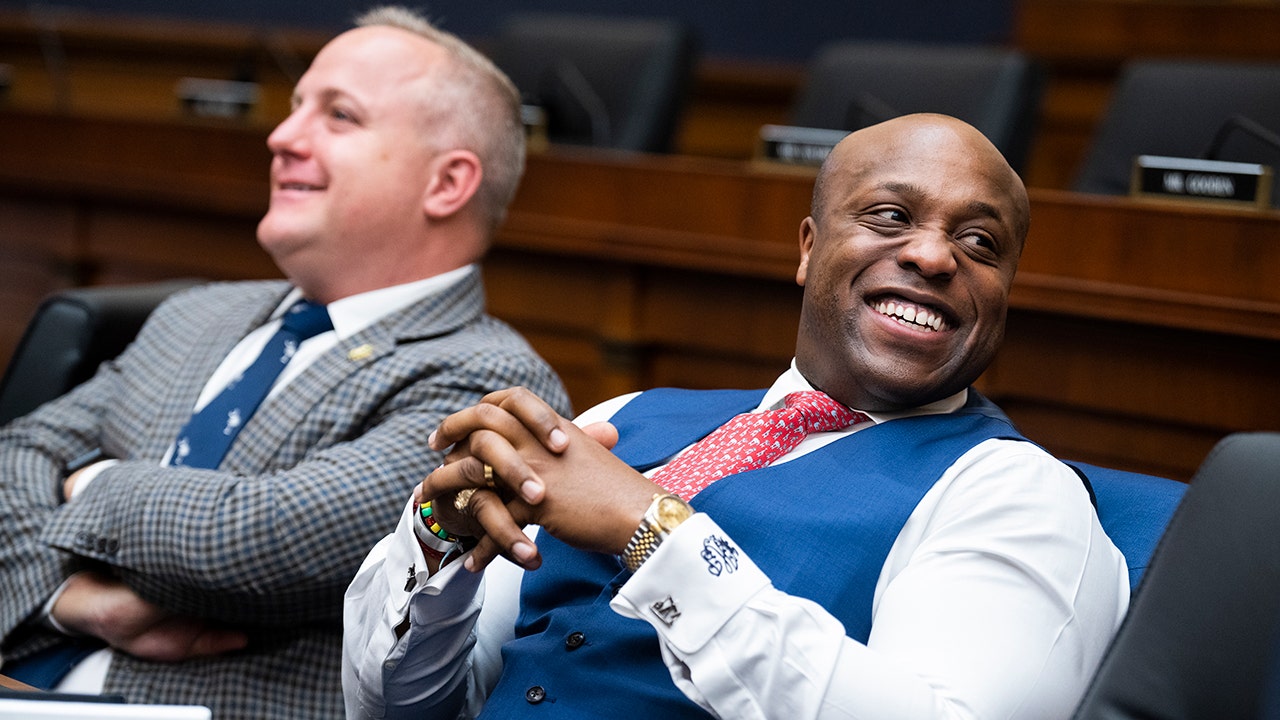Montana
Elder Stevenson dedicates Helena Montana Temple, Church’s 178th
/cdn.vox-cdn.com/uploads/chorus_asset/file/24735822/merlin_2985463.jpg)
HELENA, Montana — As Elder Gary E. Stevenson of the Quorum of the Twelve Apostles arrived at the Helena Montana Temple during the temple’s dedication weekend, he glanced above the 9,797-square-foot building’s entrance at the uppercase inscription found on every temple of The Church of Jesus Christ of Latter-day Saints: “HOLINESS TO THE LORD. THE HOUSE OF THE LORD.”
“It is really quite a profound observation to be able to see that and then think about the significance of what that means — the house of the Lord, with holiness to the Lord,” Elder Stevenson said, “and now to be in Helena, to see that and to be able to participate in the temple’s dedication, which dedicates it as the house of the Lord, and with all of that done with holiness to the Lord.”
The Apostle dedicated the Helena Montana Temple on Sunday, June 18, in two sessions that were broadcast to meetinghouses throughout the temple district, which comprises stakes in Helena, Butte, Bozeman and two in Great Falls, and covers about half of the Big Sky State.
The clouds roll over the Helena Montana Temple at dusk on the evening before the temple’s dedication. Video by Colter Peterson, who will be providing photos for our coverage later today @the_churchnews pic.twitter.com/xitLUMXBPN
— Scott Taylor (@RST_Taylor) June 18, 2023
“This temple dedication,” he said, “serves as a testament of the strength and devotion of the Saints who reside in this beautiful region of Montana.”
Joining Elder Stevenson for the dedication services were his wife, Sister Lesa Stevenson; Elder Kevin R. Duncan, a General Authority Seventy and executive director of the Temple Department, and his wife, Sister Nancy Duncan; Elder Randall K. Bennett, a General Authority Seventy and counselor in the North America Central Area presidency; and Michael Suhaka, managing director of the Temple Department.
From left, Elder Kevin R. Duncan, a General Authority Seventy and Temple Department executive director, and his wife, Sister Nancy Duncan, Elder Gary E. Stevenson of the Quorum of the Twelve Apostles and his wife, Sister Lesa Stevenson, Elder Randall K. Bennett, a General Authority Seventy and counselor in the North America Central presidency, and his wife, Sister Shelley Bennett, and Michael Suhaka, managing director of the Temple Department, and his wife, Sheri Suhaka, pose for a photo between dedication sessions of the Helena Montana Temple on Sunday, June 18, 2023, in Helena, Montana.
Colter Peterson, for the Deseret News
With the Church’s latest dedicated temple — No. 178 of 315 total temples, including those under construction or announced and in planning — Latter-day Saints in that “beautiful region of Montana” can more easily and frequently attend the temple and be better connected to and with Heavenly Father and His Son Jesus Christ, through sacred covenants and ordinances and participating in instruction and worship.
Temple trips no longer a ‘journey’
In thoughtfully preparing for the dedication and while studying the Church’s history in the state, Elder Stevenson said he realized how remarkable it is for the Latter-day Saints in central Montana to have a house of the Lord in their midst now.

Latter-day Saints depart the Helena Montana Temple between dedication sessions on Sunday, June 18, 2023, in Helena, Montana.
Colter Peterson, for the Deseret News
“On one hand, they have had this relatively close proximity to Church headquarters — it is long drive, but it’s drivable,” he said of the 485-mile distance between Helena and Salt Lake City and the driving time of just under seven hours.
“And then, we think of the bookends of legacy temples that have been a more drivable distance for them,” he noted of the Idaho Falls Idaho and Cardston Alberta temples, at 270 and 230 miles respectively from Helena via the interstate.
Then, the Billings Montana Temple was announced in 1998 and dedicated in 2000, followed by the Helena temple. A third house of the Lord for the state —the Missoula Montana Temple — was announced by President Russell M. Nelson in April 2022 general conference.

The cornerstone marking the dedication year of the Helena Montana Temple is seen on Sunday, June 18, 2023, in Helena, Montana.
Colter Peterson, for the Deseret News
“What a great blessing it is now for this great area of Montana to have access to a temple like this now,” Elder Stevenson said. “It is part of the blessings that are coming to us as our dear Prophet is so focused on gathering Israel on both sides of the veil. This temple will bless the lives of many people.”
Sister Stevenson said attending a temple dedication is always a blessing, but one close to home is an added joy, especially when the Stevensons cross paths with longtime acquaintances like 94-year-old Elsie Gruel of Great Falls. She first became acquainted with Elder Stevenson a number of years ago when he visited during a Montana fishing trip and accompanied her to a horse sale.

Elder Gary E. Stevenson of the Quorum of the Twelve Apostles and his wife, Sister Lesa Stevenson, pose for a photo with 94-year-old Edith Elsie Gruel, center, between dedication sessions for the Helena Montana Temple on Sunday, June 18, 2023, in Helena, Montana.
Colter Peterson, for the Deseret News
“But even with the people you don’t know, you’re instantly connected,” Sister Stevenson continued. “Your hearts connect — you have the same thoughts, the same goals, the same desires and a love for our Savior.
“And to have this temple here for these humble, sweet people — it’s just been their dream,” she continued. “They never thought this would happen. And now these temple blessings are taking place in their part of the world.”

Elder Gary E. Stevenson of the Quorum of the Twelve Apostles and his wife, Sister Lesa Stevenson, greet young members who are helping to provide shoe coverings for members ahead of the first dedicatory session of the Helena Montana Temple on Sunday, June 18, 2023, in Helena, Montana.
Colter Peterson, for the Deseret News
Fast-turnaround temple milestones
President Nelson announced a temple for Helena on April 4, 2021 — one of 20 locations identified that day during April 2021 general conference. Of the other 19 temples announced, 10 are under construction, one is scheduled for its groundbreaking, five have sites identified and three are earlier in planning and design.
Less than three weeks after the announcement, on April 20, 2021, the Church released a site location and exterior rendering for the Helena temple.
Elder Vern P. Stanfill — a General Authority Seventy and native of Townsend, Montana, about 30 miles from Helena — presided over the temple’s June 26, 2021 groundbreaking. The temple sits on a 4.8-acre site at 1260 Otter Road, built atop the location of a previous stake center, which was razed to make way for the new house of the Lord. A new stake center was built adjacent to the temple and has a large room that serves as a waiting area for the temple.

The sun sets on the new Helena Montana Temple of The Church of Jesus Christ of Latter Day Saints on Saturday, June 17, 2023, in Helena, Montana.
Colter Peterson, for the Deseret News
The timings of the Helena Montana Temple milestones have been among the Church’s fastest turnarounds in the past two decades. The two months and 22 days from announcement to groundbreaking is the shortest, and the 26 months and 15 days from announcement to dedication is the second fastest, just behind the 24 months and 27 days of The Gila Valley Arizona Temple in 2010.
Unexpected announcement
Still, up until the temple’s 2021 announcement, Latter-day Saints in Helena and throughout west-central Montana thought a local house of the Lord was something of the future. Helena sits among four temples — the Billings, Cardston, Idaho Falls and Rexburg Idaho temples, all within a three-and-a-half to four-hour car ride.
“We didn’t anticipate having a temple this soon, because it seems we lacked the growth and numbers necessary to support one,” said Donna Romney, wife of Helena Montana Stake President Bret R. Romney.

From left, Elder Kevin R. Duncan, a General Authority Seventy and Temple Department executive director, Elder Gary E. Stevenson of the Quorum of the Twelve Apostles and Elder Randall K. Bennett, a General Authority Seventy and counselor in the North America Central presidency, chat in front of the new Helena Montana Temple following a walkthrough on Saturday, June 17, 2023 — the day before the temple’s dedication — in Helena, Montana.
Colter Peterson, for the Deseret News
“Now we get to be part of this miracle of temples being brought to smaller areas. The temple is providing more opportunities to share the gospel of Jesus Christ, and we are already seeing growth as people are drawn to the house of the Lord.”
And President Romney sees a wide swath of blessings to Latter-day Saints in the temple district — not only by making and keeping the covenants through temple ordinances and strengthening testimonies of Heavenly Father and Jesus Christ, but also by simply serving in the temple.
“Over the years, we’ve always heard temple workers relate how impactful their temple service is individually and for their marriage and family,” President Romney said. “Now we’ll have eight to 10 times more temple workers from our stake. It’s exciting to anticipate how that will bless the lives of our stake members and wards and branches.
“So many blessings will come from having a dedicated house of the Lord so close.”

Elder Jared Cox wears a tie clip in the shape of Montana while talking with Elder Gary E. Stevenson of the Quorum of the Twelve Apostles, not pictured, between dedication sessions of the Helena Montana Temple on Sunday, June 18, 2023 in Helena, Montana.
Colter Peterson, for the Deseret News
‘A wonderful history’ in Montana
Early in the second half of the 1800s, Church members began acquiring livestock from emigrants through present-day Montana and hauling freight from Salt Lake City and back again. A small number of Latter-day Saints settled in Montana to mine or to sell supplies when gold was discovered in 1862, and more moved in later to establish ranches or help build a railroad linking Ogden, Utah, to Butte.
The year 1896 proved pivotal for the Church in Montana, only a year after the state’s first branch was established in Lima, a small town just north of the Idaho’s northeastern border.
That year, Edward Stevenson of the First Council of the Seventy — Elder Stevenson’s third-great-grandfather — toured the area with Matthias Cowley of the Oneida (Idaho) Stake presidency to minister to Latter-day Saints and gather the less active. Besides organizing several branches, they met with Montana Gov. John E. Rickards, who became a friend to the Church. And that same year, the Montana Mission was formed, a precursor to the present-day Billings Montana Mission.

Elder Gary E. Stevenson of the Quorum of the Twelve Apostles, left, greets Patricia Martinez, from Butte, Montana. as leadership and members arrive ahead of the first dedicatory session of the Helena Montana Temple on Sunday, June 18, 2023, in Helena, Montana.
Colter Peterson, for the Deseret News
“So, within three years of the Salt Lake Temple being dedicated, we have the Montana Mission being organized — that is pretty remarkable,” said Elder Gary E. Stevenson. “The Church has had great representation here for many, many years, and has a wonderful history here.”
By the end of 1920, Church membership in Montana totaled more than 1,000. In 1953, Elders Spencer W. Kimball and LeGrand Richards created Montana’s first stake, in Butte. And by 1960, membership had increased to nearly 24,000.
Today, Montana is home to some 51,000 Latter-day Saints in 13 stakes, with two dedicated temples and a third announced.

Elder Gary E. Stevenson of the Quorum of the Twelve Apostles walks through the grounds of the new Helena Montana Temple following a walkthrough on Saturday, June 17, 2023 — the day before the temple’s dedication — in Helena, Montana.
Colter Peterson, for the Deseret News
The temple’s true ‘beauty’
Elder Stevenson joined with others in marveling at the Helena Montana Temple’s beauty. “Yet, more powerful than the awe-inspiring physical elements of the temple are the feelings it invokes,” he said, adding that it was an unexpected result of the temple open-house visits made by friends, neighbors and residents of Helena and the surrounding region.
“Many were touched to learn that even our young people serve in the temple and how [they show] their love to their departed ancestors by offering them sacred proxy ordinances,” the Apostle said. “Others were fascinated to learn that husbands and wives are married here — not just for time but for eternity.”
Temples, then, are beautiful buildings designed to provide something even more beautiful: the Lord’s sacred ordinances.

Heidi Clifton is embraced by Susan Blatter between between dedication sessions of the Helena Montana Temple on Sunday, June 18, 2023, in Helena, Montana.
Colter Peterson, for the Deseret News
“We honor the Lord by building a beautiful structure, as did Solomon in the Old Testament, but we honor Him more by performing the sacred ordinances that only take place in a dedicated house of the Lord,” said Elder Stevenson, who then cited Doctrine and Covenants 84:20: “Therefore, in the ordinances thereof, the power of godliness is manifest.”
The open house and a ‘temple language’
More than 30,000 people — two to three times more than expected — attended the Helena temple open house, held May 18 through June 3. Latter-day Saints living throughout the temple district received talking points suggested by the Temple Department and given to volunteers helping with the public tours.
Jim and Suzi Stanger, co-chairs for the open house and dedication committee, said local members not only used the talking points in inviting friends and neighbors to the open house, but the doctrine and principles contained carried over to Latter-day Saints’ testimonies, talks and expressions.

The sun shines on the new Helena Montana Temple of The Church of Jesus Christ of Latter Day Saints on Saturday, June 17, 2023, in Helena, Montana.
Colter Peterson, for the Deseret News
“There’s a fluency now — it’s like now our five stakes speak a ‘temple language,’” Suzi Stanger said. “It was amazing how it transformed being able to share the temple in a personal way as a member with both members and nonmembers.”
Jim Stanger said many visitors came intrigued by the temple’s unique construction — the Church’s first modular method using a design-manufacture-install process.

Local members of The Church of Jesus Christ of Latter Day Saints carry flowers into the new Helena Montana Temple the day before the temple’s dedication on Saturday, June 17, 2023, in Helena, Montana.
Colter Peterson, for the Deseret News
He and others leading tours would talk about the physical building outside. After stopping and pointing out the “Holiness to the Lord; the house of the Lord” inscription above the entrance, the tours then focused on the talking points of covenants, ordinances, Heavenly Father’s plan, Jesus Christ and His Atonement, covenants, ordinances and the purpose of temples.
Said Suzi Stanger: “You could see it was transformative, that they felt the Spirit. … Montana people are very sincere, and I think that was one thing that really captured them — the sincerity of the focus on the Savior.”
What they were saying
Dedication attendees came from Helena, across the temple district and beyond. They included a foursome from the Utah National Guard’s 19th Special Forces: Maj. Chris Biesinger, Spanish Fork; Lt. Andrew Minkler, Cedar City; 1st Sgt. Bradley Curtis, Draper; and Staff Sgt. Benjamin Hardy, West Jordan. All were training at nearby Camp Fort Harrison and received permission to attend.

Elder Gary E. Stevenson of the Quorum of the Twelve Apostles and his wife, Sister Lesa Stevenson, welcomes 1st Lt. Andrew Garrett Minkler and three other members of the Utah National Guard, 19th Special Forces, ahead of the first dedicatory session of the Helena Montana Temple on Sunday, June 18, 2023, in Helena, Montana. The Guardsmen are training in nearby Camp Fort Harrison and received permission to attend the broadcast at the stake center next to the temple.
Colter Peterson, for the Deseret News
What did attendees feel during the dedication?
“I just felt an incredible amount of peace and joy, and I’m looking forward to bringing my children here and being together as a family,” said Tiffany Hobson of Rivers Edge Ward in the Great Falls Montana Stake.
Added her husband, Brad Hobson, as his voice cracked with emotion: “I felt love from God. I felt gratitude. And I felt like He cares about the Saints here in this region.”
Three young women from the Helena Montana Stake shared what they learned from the Spirit.

Members attending the Helena Montana Temple dedication exit the temple following the morning session on Sunday, June 18, 2023 in Helena, Montana.
Colter Peterson, for the Deseret News
“During one of the talks, it just hit me that we weren’t the only people in that room — other people who have passed on, they were in the temple with us,” said June Lay of the Helena 4th Ward. “And so it’s really cool to know how important this temple is to everyone.”
Added her sister, Ruth Lay: “I was super happy to be able to go in. This is the first dedication I’ve ever been to — and I really felt the spirit.
Anna Christensen of the Helena 6th Ward agreed. “I felt the Spirit, and it helped me feel peace in this world.”
![]()

Montana
Second Montana ski resort looks to turn wastewater into powder
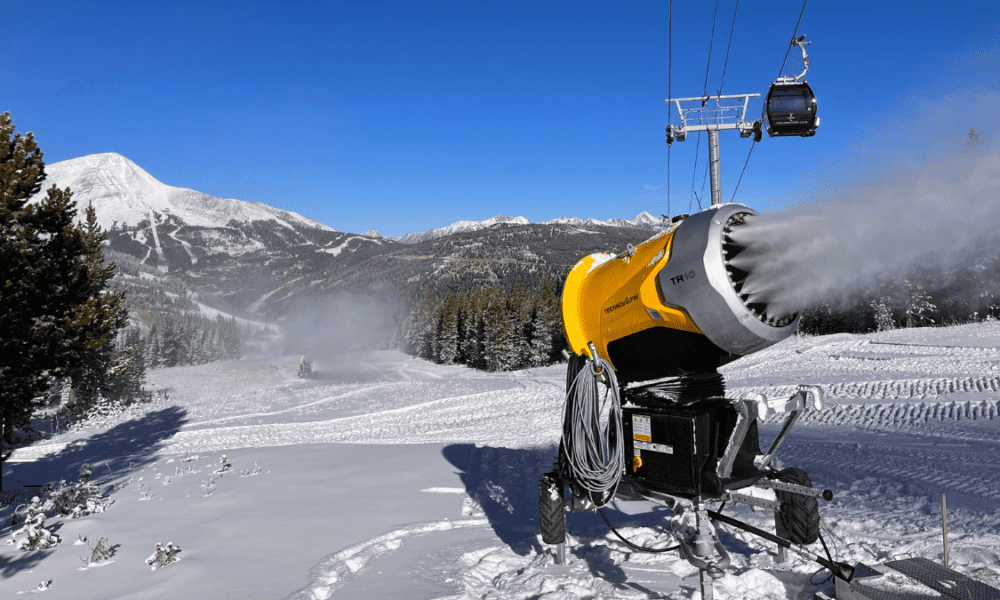
The Spanish Peaks Mountain Club has requested a permit from the Montana DEQ.
By Justin Franz MONTANA FREE PRESS
The Spanish Peaks Mountain Club in Big Sky has asked for a permit from the Montana Department of Environmental Quality to let it turn wastewater into snow for skiing and snowboarding. The private club is the second Montana ski area to try and implement snowmaking technology that proponents say is good for the environment and skiers amid a warming climate.
More than a dozen ski areas in eight states, plus some in Canada, Switzerland and Australia, use wastewater to make powder. This past winter, the Yellowstone Club near Big Sky became the first in Montana to turn what was once sewage into snow. The Spanish Peaks Mountain Club and Yellowstone Club share a common parent company, CrossHarbor Capital Partners, but they operate as separate businesses. The Spanish Peaks terrain is operated by Big Sky Resort and accessible to the public.
If approved, Spanish Peaks Mountain Club would use the treated water to make snow on approximately 44.5 acres of groomed runs on Spirit Mountain and the Spanish Creek base area and about 40.7 acres in the Southern Comfort ski area. The ski area would mostly use the treated snow in November and December to build a base during the early season.
The project would be built out in two phases. During phase one, the ski area would use 23 million gallons of treated water per year to make about 18 to 24 inches of snow. During phase two, that would increase to 44 million gallons of water annually.
DEQ has prepared a draft environmental assessment and is accepting comments on the plan through June 6.
In an emailed statement to Montana Free Press, Spanish Peaks’ Vice President of Environmental Operations Richard Chandler wrote, “We are very excited about this effort and appreciate the Department of Environmental Quality’s careful review. The conservation community in Montana has embraced the concept of turning reclaimed water into base layer snow to reuse our precious resources, recharge the aquifer and extend cold water flow into our rivers in the late summer months. Projects like these will help add resiliency to the Gallatin River, especially during drought years.”
Chandler, who also oversees the Yellowstone Club’s environmental operations, has previously said that turning recycled water into snow is better for the environment than just releasing it into a river, which normally is what happens. By shooting it through the snowmaking equipment (it’s essentially misted onto the slopes as snow) the wastewater is treated again. Then, as it melts in the spring and enters the ground, it’s filtered a third time. Because of that, groups like the Gallatin River Task Force, Trout Unlimited, American Rivers, Great Yellowstone Coalition and the Association of Gallatin Agricultural Irrigators all supported the Yellowstone Club project.
The effort to turn wastewater into snow in Big Sky dates back more than a decade. In 2011, the Gallatin River Task Force, Yellowstone Club and DEQ teamed up to study the concept. The idea was that as climate change made the region’s snowpack more unpredictable, they could serve skiers and the watershed by making snow from treated water that is traditionally just put into rivers and other bodies of water. That winter they successfully turned a half-million gallons of wastewater into two acres of snow about 18 inches deep.
In 2020, the Yellowstone Club applied for a permit from DEQ to expand that pilot program into a permanent snowmaking operation on Eglise Mountain. The following year, the state issued a permit allowing the Yellowstone Club to turn 25 million gallons of wastewater into snow annually. Two years and $12 million later, the new system began making snow last November.
Under the current plan, 80% of the recycled water comes from the Big Sky community, and 20% comes from the Yellowstone Club. For the Spanish Peaks project, all of the water will come from the Big Sky County Water and Sewer District wastewater treatment facility.
Montana
Q&A: Jon Tester, Democratic Candidate for U.S. Senate
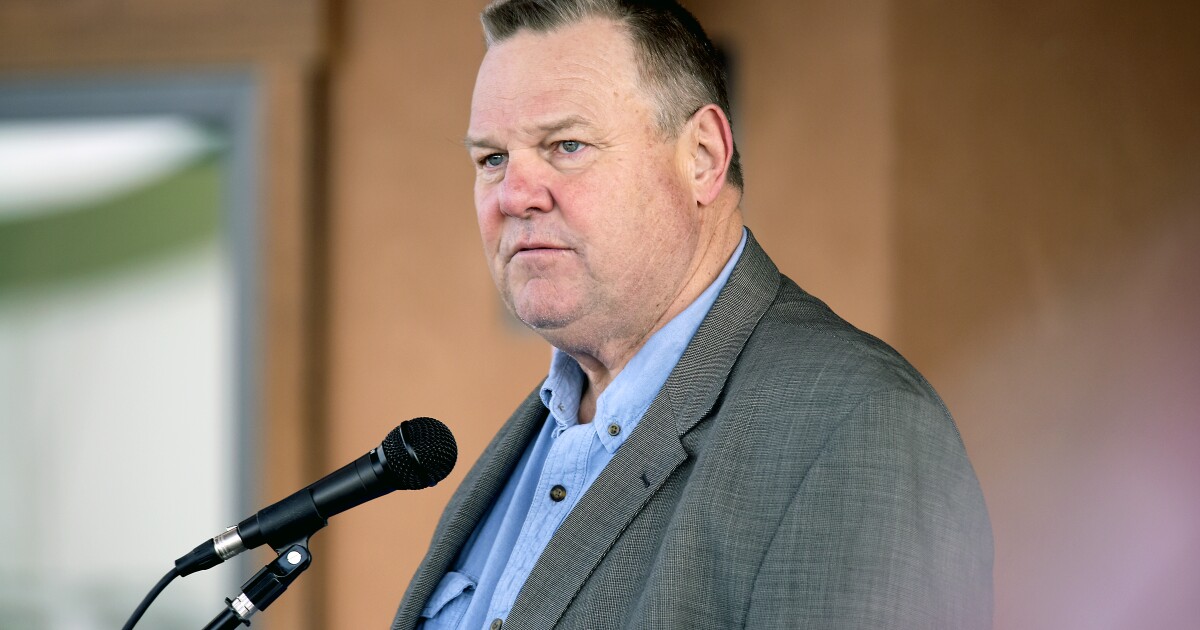
We are gathering information from all statewide candidates as a resource for the 2024 Primary Elections. Responses were limited to 200 words per question. Political attacks may have been removed, but otherwise, the responses are published unedited.
What is your full name as it will appear on ballots?
Jon Tester
What is your age?
67
Where do you live?
Big Sandy, MT
What is your education background?
College of Great Falls, Bachelor of Science in Music
Please list your current and previous occupations.
U.S. Senator, dirt farmer, music teacher for Big Sandy public schools
What motivated you to seek a seat in the U.S Senate?
Simply put, the Montana we know and love is changing. Everything from housing to groceries is more expensive as out-of-state multimillionaires move here and buy up our land, using Montana as their personal playground.
It’s putting a strain on everything – on prices, on our local infrastructure, on our towns and our parks and our public lands. With so much changing, we’ve got to have somebody in the Senate who’s willing to fight for our Montana way of life.
I still farm the land just outside of Big Sandy that my grandparents homesteaded more than 100 years ago. I feel those changes that are going on in Montana right now, every day.
Montana needs somebody back in Washington, DC who understands rural America. Someone who fights for our freedoms and goes to bat for our veterans, our family farms and ranches, our working families, our health care workers and our teachers. I’m running to keep up the fight for those folks, and to make sure our kids and grandkids can grow up in the same Montana we know and love. Montana is the greatest state in the greatest country in the world and it’s damn sure not for sale.
What, if anything, should the Senate do to address the federal deficit?
The deficit is out of control and both parties are to blame. In Montana, we know how to balance a budget and live within our means. That is why I authored a balanced budget proposal. It would protect Social Security and Medicare benefits that our seniors have earned while still forcing the federal government to stop racking up the debt and passing it along to our kids and grandkids. We also need to hold massive corporations accountable and make them pay their fair share.
Yes or no, do you support a federal ban on abortion?
NO.
Montanans of all stripes don’t want the federal government telling them what to do, and they don’t want politicians or judges stripping away their personal freedoms. Just last year, politicians in Montana ignored the voices of the voters and passed abortion bans. I opposed these bans and will always fight to protect Montana women’s freedom to make their own health care decisions.
What, if anything, should the Senate do to address climate change?
There is no question about it, climate change is impacting our economy and our way of life. Sharla and I see these impacts firsthand on our farm, where significant droughts have led to some of the toughest harvests in recent years. Wildfire seasons burn longer and more intensely, and taxpayers are stuck with the bill, paying untold billions of dollars to rebuild after extreme weather events.
We should be developing clean energy technologies to tackle climate change, create good-paying American jobs, and secure our energy independence, and Montana has the opportunity to lead the way. China is actively working to beat America in the clean energy sector in hope of taking over as the world’s strongest economy. We can’t afford to lose this competition. That’s why we should invest directly in Montana companies researching next-generation energy technologies that are affordable and lower costs for consumers. And my Bipartisan Infrastructure Bill secured investments to update our energy grids to prevent and protect against wildfire. Traditional energy sources like oil and gas remain a critical part of how we power our country, so we need to continue to invest in development of technologies like carbon capture and storage to reduce carbon emissions.
What changes, if any, should be made to the way elections and campaigns are funded?
Elected leaders should work for the people, not those who can cut the biggest check. It’s way past time to kick dark money out of politics. We should have done it yesterday.
The Supreme Court’s Citizens United v. FEC decision was disastrous. It flooded our elections with mind-boggling amounts of money and made a mess of our democracy. Since then, I’ve fought to overturn that decision with my “Corporations Are Not People” constitutional amendment, and I urge my colleagues in the Senate to join me in making sure hardworking Montanans, not massive corporations and out-of-state billionaires, get to pick their elected officials.
I will also continue fighting for better transparency in campaign finance, like my Sunlight for Unaccountable Non-profits (SUN) Act, which would take huge strides towards eliminating dark money by requiring the IRS to publicly disclose donors who give over $5,000 to certain tax-exempt groups engaging in political activity.
Hardworking Montanans should be the ones deciding their elections, not out-of-state special interest groups. I will always defend the voices of Montanans and put them first.
What, if anything, should the Senate do to improve the nation’s immigration laws and security at the southern border?
What’s happening on the southern border is unacceptable, and dedicating more manpower and resources is crucial to keeping Montanans safe.
That’s why I’ve called on President Biden to step up and do everything in his power to secure the border, and it’s why I supported a strong bipartisan deal to get our border under control earlier this year. This bipartisan bill would have hired more border patrol agents, cracked down on the fentanyl crisis, and tightened asylum standards – that’s why it received the strong endorsement of the National Border Patrol Council. Unfortunately, many of my colleagues decided to play politics and voted to keep the border open for another year so they could campaign on the issue.
I have been talking with Montanans, sheriffs, and mayors across the state, they all are feeling the consequences of the situation at the southern border, from stretched law enforcement budgets to fentanyl in the communities. I was proud that my bipartisan FEND Off Fentanyl Act passed to place sanctions on countries engaged in international trafficking of illegal fentanyl and give law enforcement the resources they need to battle the fentanyl crisis.
What, if anything, should the Senate do to ensure Social Security and Medicare benefits meet the needs of older adults?
I will never cut Social Security and Medicare. Full stop. For many older Montanans, Social Security is their only source of retirement income, and Medicare is their only way to access affordable life-saving health care. These are essential benefits that Montanans have spent their entire lives paying into, and I will always fight to ensure these benefits are protected – not just for today’s seniors but for all of Montana’s future generations.
There are some politicians who want to end Social Security or cut those benefits. I oppose any plan to do so. I will also stand tough against any plan to privatize Medicare, because our seniors have paid into that their whole lives and should be able to rely on it. I was also proud to pass legislation that allowed Medicare to negotiate prescription drug prices – including capping the price of insulin for seniors at $35/month – and I will fight to ensure that Montana’s nursing homes stay open and fully-staffed. Montana’s seniors can count on me to defend their hard-earned health care benefits.
What should be the top priority when managing public land?
As a lifelong Montanan, I know our public lands are foundational to our way of life and to our state’s economy. You don’t need to be a millionaire to hunt, fish, or hike in these treasured landscapes, because they belong to all of us. Our public lands play a key role for ranchers looking to graze their cattle, or local sawmills in need of timber to harvest. That is why I oppose the call from some politicians who have said they want to transfer our public lands, which would make it easier to sell our wide open spaces off to the highest bidder.
Montana has a long history of local collaboratives working together to improve management of our public lands. I worked with Montanans to protect special places like the Rocky Mountain Front, Glacier National Park, and the Gateway to Yellowstone National Park. I am also incredibly proud to have secured full funding for the Land and Water Conservation Fund, and it’s because of that work that conservation and recreation priorities for Montana’s public lands will be funded for generations to come. And I will continue to fight for bills like the Blackfoot Clearwater Stewardship Act to protect thousands of acres of public lands for future generations.
What, if anything, would you do if elected to build trust in the Senate?
When I first ran for U.S. Senate, I made a promise to Montanans that I would go above and beyond on ethics and transparency and work for them – not special interest groups.
Every day since, I’ve worked tirelessly to uphold that promise. The first thing I did was post my Senate schedule online for all Montanans to see. I was the first Senator to do this and still do it to this day – unfortunately, I’m one of the only U.S. senators who does. So I’ve introduced a bill to make that mandatory for all of my colleagues, because the American people deserve to know who their elected officials are meeting with.
I’m also fighting to crack down on lobbyist influence. I’m working to shut the revolving door by banning members of Congress from becoming lobbyists – ever. And I routinely invite retired Montana judges to conduct a voluntary ethics audits of my office, to ensure my office and I meet the high standards we set for ourselves. I think all of my colleagues should join me.
Like most Montanans, I believe a handshake means something and our word is our bond. That’s how trust in the Senate should be built – by earning it.
Montana
Alberton's Montana River Guides a leader in river safety

The Covid-induced tourism boom to Montana introduced a new audience to the Clark Fork River. For two summers, boats, tubers, kayakers, paddleboarders and river boarders had campgrounds and fishing access sites clogged.
That visitation surge has settled, but once tasted, more people are using the incredible water resources today, and who can blame them?
Most water recreation can be done with common sense safety but whitewater rafting is best done with an experienced company unless the person behind the oars has been safety certified. That’s because it’s a far cry from rowing with your buddies from Forest Grove to the Big Eddy Fishing Access sites casting flies all afternoon.
There are several rafting companies that specialize in whitewater rafting with experienced guides that will make an incredible memory for families with lots of fun, laughter and the stories they share. The shuttle back to your vehicle is happy rafters telling their favorite parts of the day.
“The Alberton Gorge is one of the most beautiful sections of river in Montana and during the summer it has incredible scenery and whitewater opportunities. It’s our specialty! But our scenic wildlife viewing floats on gentle water are becoming more popular. And these are the heart and soul of Montana River Guides,” said Mike Johnston who started the company in 1994.
Montana River Guides has certified whitewater rescue instructors and they have been training search and rescue, fire departments, and rafting companies for many years from as far away as Costa Rica and India. They are affiliated with the Whitewater Rescue Institute and every guide is trained in swiftwater rescue. They are so secure that they are the Discovery Channel’s only choice for whitewater safety.
The foundation of the rafting company is family-oriented whitewater rafting and picturesque river floating.
“We’ve always been off the beaten path, a little bit, being in Alberton,” Johnston explained. “And the longer we’ve had our company, the more we appreciate that we are not near a national park as it’s not near as crowded. That we’re not in a part of Montana that gets overwhelmed with tourism.”
However, the business has been growing steadily as more people move into Missoula and the Spokane and Coeur ‘d Alene areas as those are the repeat customers which are a huge chunk of revenue.
“A lot of our customers are local people and families,” Johnston said. “And then their visiting friends and families come and try it out. They come back year after year. But we also have a lot of tourists who used to drive through the area but have realized there’s a lot of stuff to do here for all ages so it’s almost a destination.”
Something Johnston shares that he’s noticed in his 30 years of taking people rafting is heartening.
“Families today not only include kids and maybe grandparents, but more and more people ask about floating with their dogs. We accommodate it whenever we can. Of course, we can’t do it in big whitewater but on the scenic floats on the Blackfoot or other rivers we float, we have different sized life jackets designed especially for dogs and we’ve never had a bad experience.”
Just to ensure that other rafters might not be dog-people, the requesting party must rent the entire boat, which happens anyway with so many friends and family members.
Johnston is a director of the Mineral County Chamber of Commerce as a personal supporter of local businesses but also to refer his visitors to other local establishments. Where to eat, spend the night, play pool, fill propane tanks, campgrounds that are nearby, etc. Float information and scheduling is done online at montanariverguides.com.
-

 Politics1 week ago
Politics1 week agoHouse Dems seeking re-election seemingly reverse course, call on Biden to 'bring order to the southern border'
-

 World1 week ago
World1 week agoStand-in Jose Raul Mulino wins Panama presidential race
-

 News1 week ago
News1 week agoCompass Direct LLC’s 2024 Registration in North Carolina
-
News1 week ago
UCLA to resume in-person classes after Gaza protest crackdown
-

 World1 week ago
World1 week agoTech compliance reports, Newsletter
-

 News1 week ago
News1 week agoColumbia University cancels its main commencement ceremony after weeks of turmoil
-

 News1 week ago
News1 week agoMan, 75, confesses to killing wife in hospital because he couldn’t afford her care, court documents say
-

 World1 week ago
World1 week agoPentagon chief confirms US pause on weapons shipment to Israel
